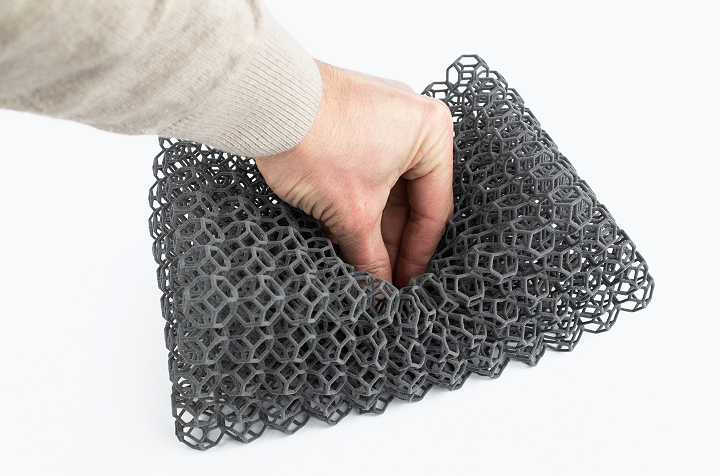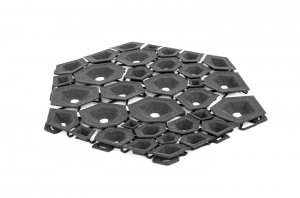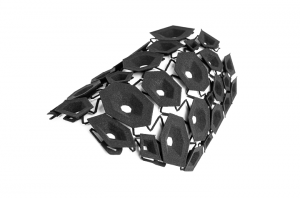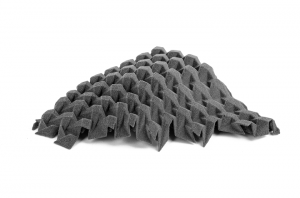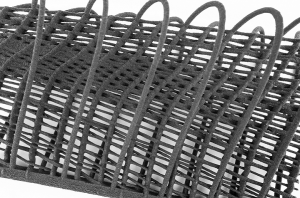Engineering, textiles, and additive manufacturing are different industries with different growth patterns, but they are connected by an important point: structures. Additionally, each of these industries have to struggle with limitations in order to build products for less money and materials and at a higher rate of speed. But rapid prototyping has changed how these things are built and opened the door to numerous new possibilities.
Selective laser sintering (SLS) 3D printing, also known as powder bed fusion, is an accurate and durable technology that, while perhaps not the fastest method in time to part, is definitely a good choice when it comes to machines that can provide repeatable results or that print batches of many things at once. It also gives users more design freedom, which is why it’s possible to 3D print materials inspired by knitting and weaving.
But engineers aren’t typically interested in textile applications, which is why the fashion industry is driving the push to reproduce flexible features through 3D printing…leading to the invention of such innovations as hexagonal shapes corresponding to hinge joints with a pivoted angle. This kind of textile structure does not have a flexible, elastic surface, but can bend under pressure and deform.
There are many applications for flexible structures in the textile world, from decorative fabrics for interior design to upholstery and scenography, which is the design and painting of theatrical scenery. Along these same lines, SLS 3D printing can be used to create flexible textiles for theatrical costumes as well, which is what Mingjing Lin and Tsai-Chun Huang – PhD candidates in Fashion and Textile research at the Royal College of Art in London – have been working on.
Lin said, “3D printing is our media to probe creative possibilities generated from merging unlike/dynamic elements, such as digital technology and craft, traditional opera and modern performance, as well as East and West.”
Two years ago, the two began working with Polish desktop SLS 3D printer manufacturer Sinterit on creating costumes for Beijing Opera performances of “Farewell My Concubine.” Lin’s specialty is 3D printing, while Huang’s is in pleating, and the two were challenged to create 3D printed costumes that were both sustainable and flexible.
These couldn’t be just any costumes – in this opera, the costumes are an extremely important part of the performance, and had to be utterly amazing. The material used for the costumes needed to fulfill two functions: successfully create and hold the shape that the artist designed, while also being wearable enough that the performers could move freely about the stage. Clearly, this was no job for sewing mere materials like silk and cotton: 3D printing was needed to create more “dramatic geometry,” as Sinterit put it.
For this daunting task, Lin and Huang used the company’s Lisa 3D printer and special Flexa TPU material, which comes in Black, Soft, and Bright for use in various applications. Flexa is very wearable, and the costumes created with the material were able to synchronize with the performers’ bodies while at the same time retaining their shapes, which would not have been possible to achieve using more traditional materials.
The deep color of Flexa Black made it perfect for this particular opera, though Flexa Bright may be a better choice for textile fiber and costume designers, as this durable material can be dyed into different colors; Flexa Soft has the lowest hardness of the series, and is often used to design sportswear prototypes and sensory fabrics.
 Obviously, those who work in textiles can find a myriad of uses for 3D printable materials that are both strong and flexible. But here’s the thing – while I noted above that engineers aren’t typically interested in this kind of application, I also believe that it would be to their best interests if they were. Think of the kinds of products they could make with materials, like Sinterit’s Flexa, that are strong enough to hold the specific shapes that are needed for different applications but are also flexible enough to bend and deform under pressure and then spring back into position. But maybe I’m not the best judge – does anyone out there know of any engineering-related applications that are using flexible textiles? Let us know!
Obviously, those who work in textiles can find a myriad of uses for 3D printable materials that are both strong and flexible. But here’s the thing – while I noted above that engineers aren’t typically interested in this kind of application, I also believe that it would be to their best interests if they were. Think of the kinds of products they could make with materials, like Sinterit’s Flexa, that are strong enough to hold the specific shapes that are needed for different applications but are also flexible enough to bend and deform under pressure and then spring back into position. But maybe I’m not the best judge – does anyone out there know of any engineering-related applications that are using flexible textiles? Let us know!
Discuss this story and other 3D printing topics at 3DPrintBoard.com or share your thoughts in the Facebook comments below.
Subscribe to Our Email Newsletter
Stay up-to-date on all the latest news from the 3D printing industry and receive information and offers from third party vendors.
You May Also Like
3D Printing Unpeeled: New Arkema Material for HP, Saddle and Macro MEMS
A new Arkema material for MJF is said to reduce costs per part by up to 25% and have an 85% reusability ratio. HP 3D HR PA 12 S has been...
3D Printing News Briefs, January 20, 2024: FDM, LPBF, Underwater 3D Printer, Racing, & More
We’re starting off with a process certification in today’s 3D Printing News Briefs, and then moving on to research about solute trapping, laser powder bed fusion, and then moving on...
3D Printing Webinar and Event Roundup: December 3, 2023
We’ve got plenty of events and webinars coming up for you this week! Quickparts is having a Manufacturing Roadshow, America Makes is holding a Member Town Hall, Stratafest makes two...
Formnext 2023 Day Three: Slam Dunk
I’m high—high on trade show. I’ve met numerous new faces and reconnected with old friends, creating an absolutely wonderful atmosphere. The excitement is palpable over several emerging developments. The high...


